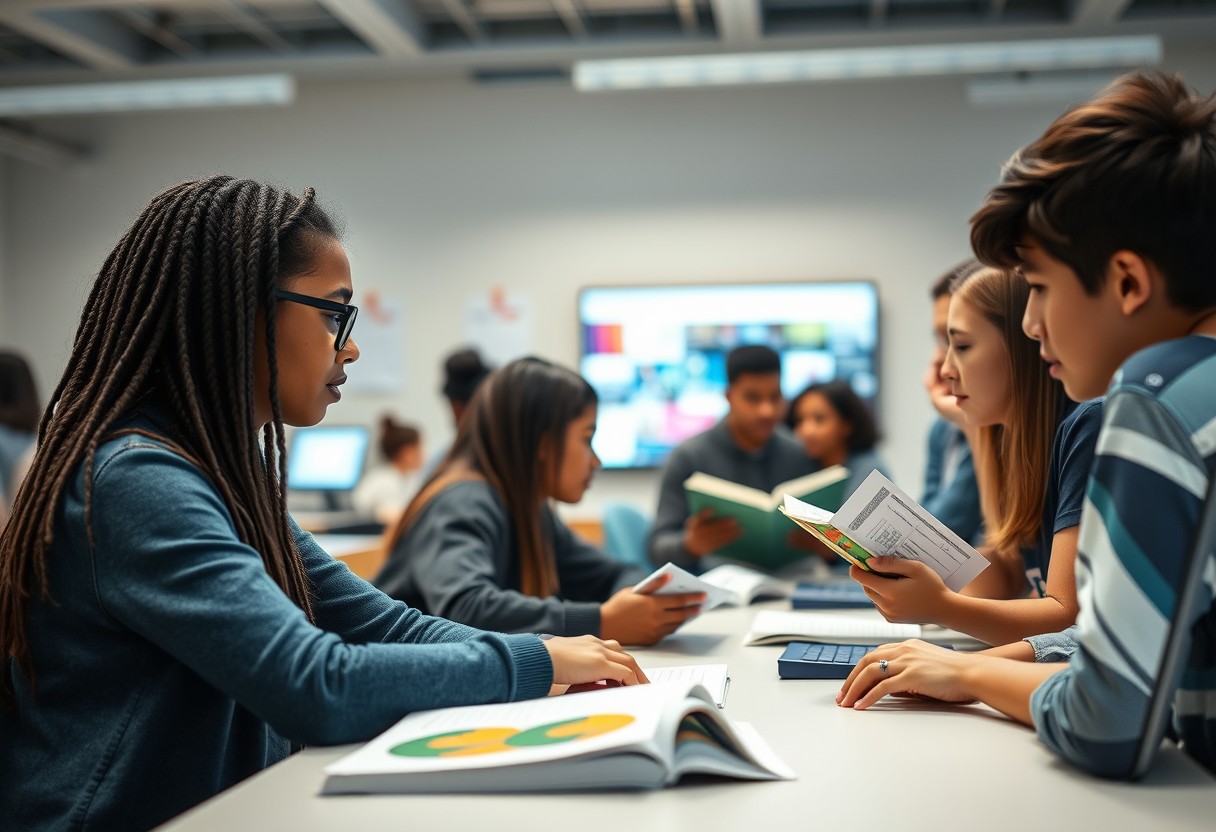There’s a fascinating world where Intelligent Tutoring Systems (ITS) harness the power of Artificial Intelligence (AI) to offer learners immediate and personalized assistance. These systems utilize advanced algorithms to analyze student responses, adapt to individual learning styles, and deliver real-time guidance to enhance educational outcomes. By continuously assessing performance and providing targeted feedback, ITS revolutionizes the learning experience by tailoring instruction to each student’s needs, making education more effective and engaging.
Defining Intelligent Tutoring Systems
While discussing how Intelligent Tutoring Systems (ITS) use AI to provide real-time guidance, it’s crucial to understand the foundation of these systems and their evolution over time.
Historical Background
Historically, the concept of ITS dates back to the 1970s when researchers began exploring the potential of using computers to personalize and enhance the learning experience. Early systems focused on providing individualized instruction to students based on their progress and responses, marking a significant shift from traditional classroom-based teaching methods.
Modern Applications
Intelligent Tutoring Systems have come a long way since their inception, thanks to advancements in artificial intelligence and machine learning. Today, these systems leverage AI algorithms to analyze vast amounts of data in real-time, enabling them to adapt and tailor their guidance to the specific needs and learning styles of each student.
Another crucial aspect of modern ITS is their ability to provide personalized feedback instantly, helping students identify and rectify mistakes as soon as they occur. This immediate intervention not only enhances the learning process but also boosts student engagement and motivation.
The Role of Artificial Intelligence in ITS
It plays a crucial role in the functionality of Intelligent Tutoring Systems (ITS), enabling these systems to provide personalized and real-time guidance to learners. Through a combination of various AI techniques, ITS can adapt to each student’s individual learning style, pace, and needs, offering tailored assistance to enhance the learning experience.
Machine Learning Algorithms
For Machine Learning Algorithms, ITS leverages data-driven algorithms to analyze and interpret patterns in students’ learning behavior. By continuously collecting and processing data on how students interact with the system, ITS can make predictions and recommendations to optimize the learning process. This dynamic approach allows the system to adjust its guidance in real time, meeting the unique requirements of each student.
Natural Language Processing
With Natural Language Processing, ITS can understand and generate human language, enabling seamless communication between the system and the student. By processing text and speech inputs, ITS can provide instant feedback, answer questions, and engage in dialogue to clarify concepts. This capability enhances the interactive nature of the system, fostering a more engaging and effective learning environment.
Role: In ITS, the integration of Artificial Intelligence, particularly through Machine Learning Algorithms and Natural Language Processing, plays a pivotal role in delivering personalized and adaptive guidance to learners. By harnessing the power of AI, ITS can cater to individual learning needs, enhance comprehension, and provide valuable insights to both students and educators.
Real-Time Guidance in ITS
Adaptive Assessment
With the help of Artificial Intelligence (AI), Intelligent Tutoring Systems (ITS) can offer adaptive assessments to students in real-time. These systems continuously analyze the student’s performance and understanding of the material to tailor the questions and tasks accordingly. This adaptive approach ensures that students are constantly challenged at an appropriate level, helping them learn more effectively.
Personalized Feedback
Any AI-driven Intelligent Tutoring System provides personalized feedback to students as they navigate through lessons and exercises. This feedback is tailored to each student’s specific needs, addressing their strengths and weaknesses in real-time. By offering personalized feedback, the system can guide students on how to improve their performance and comprehension, ultimately leading to better learning outcomes.
This personalized feedback can be crucial in helping students not only understand where they are making mistakes but also in guiding them on the right track towards mastery. By receiving immediate and relevant feedback, students can make corrections and adjustments quickly, enhancing their learning process.
AI-Driven Student Modeling
Knowledge Representation
Not only do Intelligent Tutoring Systems provide real-time guidance, but they also utilize AI-driven student modeling to tailor their instruction to each individual learner. Student modeling involves representing the knowledge, skills, and learning preferences of each student in a way that the AI system can understand and adapt to.
Cognitive Modeling
Not only does Student modeling focus on knowledge representation, but it also incorporates cognitive modeling to understand how students learn and retain information. By analyzing a student’s problem-solving strategies, decision-making processes, and misconceptions, the AI system can provide personalized guidance in real time.
Modeling the cognitive processes of students enables Intelligent Tutoring Systems to offer targeted feedback and adapt their teaching methods to maximize learning outcomes. By continuously analyzing and updating the student model based on interactions during learning sessions, the AI can provide increasingly tailored and effective guidance.
How AI Analyzes Student Performance
Many intelligent tutoring systems use AI to analyze student performance in real time to provide personalized guidance. Through sophisticated algorithms and data processing techniques, AI can extract valuable insights from the vast amount of data collected during student interactions with the system.
Data Mining Techniques
Performance data is collected and analyzed using data mining techniques such as clustering, classification, regression, and association. Clustering algorithms can group students based on similarities in their performance, allowing the system to tailor guidance to specific clusters. Classification algorithms can predict student outcomes based on past performance, enabling the system to intervene before a student struggles.
Pattern Recognition
Pattern recognition involves using AI to identify meaningful patterns in student performance data. This can help the system understand how students learn and where they encounter difficulties. By recognizing patterns, AI can adapt its guidance to address specific learning needs and preferences of individual students.
Data patterns can reveal insights into how students progress through different concepts, which learning strategies are most effective, and where additional support may be needed. By leveraging these patterns, intelligent tutoring systems can provide targeted interventions to enhance student learning outcomes.

Real-Time Intervention Strategies
Adaptive Difficulty Adjustment
Unlike traditional tutoring methods, Intelligent Tutoring Systems (ITS) can adapt the difficulty of the tasks based on the learner’s performance in real-time. This feature ensures that learners are continuously challenged at the right level, keeping them engaged and motivated throughout the learning process. By dynamically adjusting the difficulty level, ITS can prevent learners from becoming frustrated with tasks that are too difficult or bored with tasks that are too easy.
Context-Aware Support
An vital aspect of Intelligent Tutoring Systems is their ability to provide context-aware support to learners. By analyzing various data points such as the learner’s interactions, progress, and preferences, ITS can offer personalized feedback and guidance tailored to the individual’s needs and learning style. This personalized approach enhances the learning experience, making it more effective and efficient.
Context-Aware Support goes beyond simply adjusting the difficulty level of tasks; it also considers factors such as the learner’s background knowledge, learning pace, and even emotional state to provide optimal support and guidance. This level of personalization is what sets ITS apart from traditional tutoring methods and allows for a truly adaptive and individualized learning experience.
The Importance of Human-AI Collaboration
Teacher-AI Partnership
Keep in mind that the collaboration between teachers and AI in Intelligent Tutoring Systems is not about replacing human educators; rather, it is about enhancing their capabilities. An effective teacher-AI partnership leverages the strengths of both parties, with the AI offering personalized learning paths based on data analysis while the teacher provides emotional support and motivation.
AI-Supported Instructional Design
One crucial aspect of AI in Intelligent Tutoring Systems is its role in supporting instructional design. The AI can analyze a student’s interactions with the system in real-time, pinpointing areas where the student is struggling and adjusting the lesson accordingly. This dynamic adaptation ensures that the learning experience is tailored to the student’s needs, promoting efficient learning.
Another significant benefit of AI-supported instructional design is its ability to provide immediate feedback. This real-time guidance enables students to correct mistakes as they occur, reinforcing learning and preventing the development of misconceptions. By offering instant feedback, AI enhances the efficiency of the learning process and keeps students engaged.
Addressing Ethical Concerns in AI-Driven ITS
Bias Mitigation Strategies
Strategies to mitigate biases in AI-driven ITS include ensuring diverse and representative training data, conducting regular bias audits, and implementing bias detection algorithms. By incorporating these measures, developers can reduce the risk of perpetuating pre-existing biases in the system and promote fairness and equity in the learning process.
Transparency and Explainability
Strategies to enhance transparency and explainability in AI-driven ITS involve providing clear system documentation, offering detailed explanations of algorithmic decisions, and enabling user feedback mechanisms. These efforts help users understand how the system works, why specific recommendations are made, and provide avenues for recourse in case of errors or misunderstandings.
Another crucial aspect of transparency and explainability in AI-driven ITS is the implementation of user-friendly interfaces that communicate the system’s processes and limitations in a comprehensible manner. This ensures that users can engage effectively with the technology and make informed decisions about their learning experience.
Scalability and Flexibility in ITS
Cloud-Based Infrastructure
All intelligent tutoring systems (ITS) require a robust infrastructure to handle the complex computations and interactions necessary to provide real-time guidance to students. For this reason, many ITS solutions are turning to cloud-based infrastructure to ensure scalability and flexibility. By leveraging cloud computing services, ITS can efficiently manage large amounts of data and scale their operations based on demand.
Multi-Agent Systems
All intelligent tutoring systems (ITS) work efficiently by incorporating various agents working together to provide personalized guidance to students. MultiAgent systems within ITS use a decentralized approach, where individual agents have their own autonomy and can communicate and collaborate with each other to achieve common goals. With this approach, ITS can adapt and adjust in real-time to students’ needs, providing more effective and personalized guidance based on each student’s unique learning style and pace.
Multi-Agent Systems within ITS allow for a dynamic and adaptable learning environment where agents can interact with each other and with students to provide timely and tailored guidance. This collaborative approach enhances the overall learning experience and ensures that students receive the best possible support throughout their learning journey.
The Future of AI in Education
Now, let’s explore the future of AI in education and the advancements that we can expect to see in the coming years. As technology continues to evolve, the potential for AI in education is vast, with intelligent tutoring systems at the forefront of innovation.
Emerging Trends in AI Research
To research into the future of AI in education, we must first consider the emerging trends in AI research. Researchers are constantly pushing the boundaries of AI to enhance personalized learning experiences, improve educational outcomes, and streamline administrative tasks for educators. Machine learning algorithms are becoming increasingly sophisticated, enabling intelligent tutoring systems to adapt in real-time to students’ needs. Additionally, the integration of natural language processing allows for more effective communication between students and AI tutors, making the learning process more engaging and interactive.
Potential Applications in Other Fields
To broaden our perspective, let’s consider the potential applications of AI in other fields beyond education. The advancements made in AI research for education can have ripple effects across various industries, from healthcare to finance. AI-powered systems can revolutionize patient care by analyzing vast amounts of medical data to provide accurate diagnoses and personalized treatment plans. In finance, AI algorithms can be utilized for predictive analytics to forecast market trends and optimize investment strategies.
Fields such as cybersecurity can also benefit from AI advancements, with machine learning algorithms detecting and preventing cyber threats in real-time, bolstering digital security measures for organizations and individuals alike.
Challenges and Limitations of AI-Driven ITS
Technical Challenges
One of the primary technical challenges facing AI-driven Intelligent Tutoring Systems (ITS) is data privacy and security concerns. These systems rely on vast amounts of data to personalize learning experiences for students, raising issues around data protection regulations and safeguarding sensitive information.
Furthermore, scalability and adaptability pose significant challenges for AI-driven ITS. As the number of users and interactions grows, the system must be able to handle the increasing complexity of data processing and provide real-time guidance effectively.
Pedagogical Limitations
To effectively utilize AI for real-time guidance, Intelligent Tutoring Systems must address pedagogical limitations such as the impersonal nature of interactions. While AI can provide personalized recommendations and feedback, it may lack the empathy and emotional intelligence that human tutors offer.
To address pedagogical limitations, ITS developers are exploring ways to incorporate emotional intelligence algorithms and natural language processing to enhance the human-like qualities of AI tutors. These advancements aim to improve the overall learning experience and bridge the gap between technology and human teaching.
With the continued development of AI-driven Intelligent Tutoring Systems, addressing these challenges and limitations is crucial to maximizing their potential in education.
Evaluating the Effectiveness of AI-Driven ITS
Quantitative Metrics
Effectiveness: After implementing an AI-driven Intelligent Tutoring System (ITS), it is crucial to evaluate its performance using quantitative metrics. These metrics can include completion rates, time spent on tasks, improvement in test scores, and the number of hints or prompts required by students. By analyzing these metrics, developers can assess the efficiency and effectiveness of the ITS in providing real-time guidance to learners.
Qualitative Feedback
On Qualitative Feedback: After analyzing quantitative data, gathering qualitative feedback is equally important in evaluating the effectiveness of an AI-driven ITS. Qualitative feedback can provide insights into students’ perceptions, satisfaction levels, engagement, and overall learning experience. This can be collected through surveys, interviews, or observational studies to understand the impact of the ITS on individual learning journeys.
Plus: Quantitative data may show the numbers, but qualitative feedback gives a deeper understanding of the human aspect involved in utilizing AI for tutoring. It helps in understanding the emotions, motivations, and challenges faced by the learners, providing valuable insights for further enhancing the ITS’s design and functionality.
Implementing AI-Driven ITS in Educational Settings
Integration with Existing Curricula
Your AI-driven Intelligent Tutoring System (ITS) can seamlessly integrate with existing curricula to enhance the learning experience for students. By aligning the ITS with the curriculum objectives and standards, students receive personalized and targeted instruction that complements their in-classroom learning. The ITS can adapt in real-time to students’ individual needs, providing tailored guidance and support to help them master complex concepts.
Teacher Training and Support
Integration of AI-driven ITS in educational settings also entails providing comprehensive training and support for teachers. Educators need to understand how to best utilize the ITS within their teaching practices, leveraging the insights and data it generates to guide their instruction. Continuous professional development opportunities should be offered to ensure that teachers feel empowered to effectively incorporate the ITS into their classrooms.
This approach not only benefits students by enhancing their learning experience but also equips teachers with valuable tools to support their pedagogical goals in an increasingly technology-driven educational landscape.
Summing up
As a final point, Intelligent Tutoring Systems heavily rely on Artificial Intelligence to provide real-time guidance to students. By utilizing algorithms that analyze student responses, track progress, and adapt to individual learning styles, these systems can offer personalized and effective learning experiences. The use of AI in education is revolutionizing how students receive instruction and guidance, ultimately leading to improved learning outcomes and a more tailored educational experience.
As we continue to harness the power of AI and technology in education, the potential for Intelligent Tutoring Systems to further enhance the learning process is vast. With the ability to provide immediate feedback, adapt lessons in real-time, and cater to individual student needs, these systems are shaping the future of education by creating more personalized and effective learning environments.
FAQ
Q: What are Intelligent Tutoring Systems (ITS)?
A: ITS are computer programs that use artificial intelligence (AI) to provide personalized instruction and feedback to learners.
Q: How do Intelligent Tutoring Systems utilize AI?
A: ITS leverage AI algorithms to analyze student data, such as performance and learning patterns, to offer tailored guidance and support in real-time.
Q: In what ways do Intelligent Tutoring Systems provide real-time guidance?
A: ITS monitor student progress continuously and adjust the learning materials and feedback in the moment to address the learner’s specific needs.
Q: What role does AI play in the real-time guidance offered by Intelligent Tutoring Systems?
A: AI algorithms in ITS can process large amounts of data quickly to identify areas where a student is struggling and provide immediate assistance or additional challenges accordingly.
Q: How do Intelligent Tutoring Systems adapt to individual learning styles?
A: ITS use AI to create personalized learning paths for each student based on their strengths, weaknesses, and preferred learning methods, ensuring a tailored educational experience.
Q: Can Intelligent Tutoring Systems provide feedback on student performance?
A: Yes, ITS can offer detailed feedback on quizzes, assignments, and tests in real-time, highlighting areas for improvement and suggesting further study materials or exercises.
Q: How do Intelligent Tutoring Systems benefit from AI technology in providing real-time guidance?
A: The use of AI in ITS allows for adaptive learning experiences, immediate responses to student needs, and the ability to track progress accurately, enhancing the effectiveness of the educational support provided.




